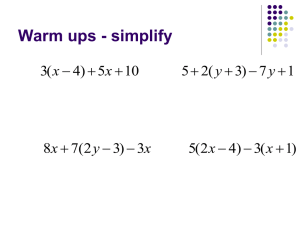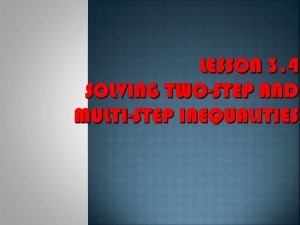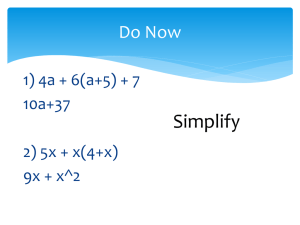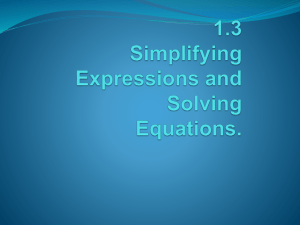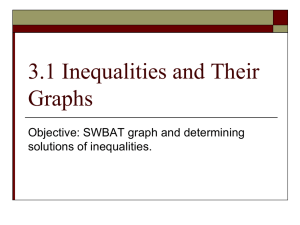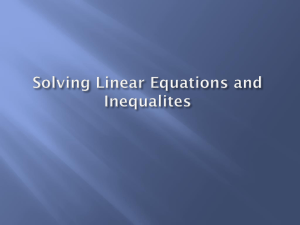+ 2 - Dalton State College
advertisement
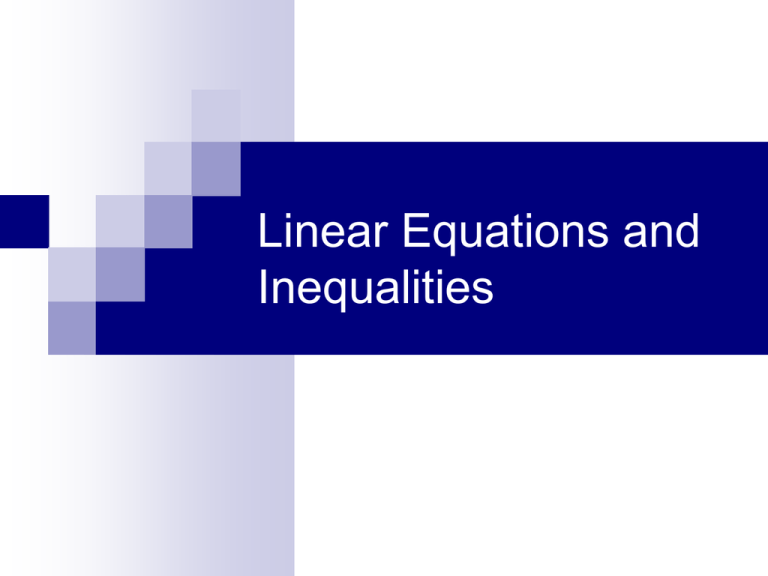
Linear Equations and Inequalities Much education today is monumentally ineffective. All too often we are giving young people cut flowers when we should be teaching them to grow their own plants. John W. Gardner Algebra is great fun - you get to solve puzzles! A Puzzle What is the missing number? –2=4 Algebra Well, in Algebra we don't use blank boxes, we use a letter (usually an x or y, but any letter is fine). So we would write: x–2=4 x–2=4 It is really that simple. The letter (in this case an x) just means "we don't know this yet", and is often called the unknown or the variable. And when you solve it you write: x=6 How to Solve Algebra is just like a puzzle where you start with something like: x–2=4 and you want to end up with something like: x=6 How to Solve Basic approach to solve: Work out what to remove to get "x = ..." Remove it by doing the opposite (adding is the opposite of subtracting) Do that to both sides How to Solve To remove it, do the opposite, in this case add 2: Do it to both sides: Which is: We want to remove the “-2" x – 2 = 4 +2 +2 0 6 x – 0 = 6 x = 6 Why did we add 2 to both sides? To "keep the balance“ Add 2 to left side Out of balance Add 2 to right side Back in balance Algebra-Balance Scale Solve simple linear equations using a balance beam representation. 3x + 3 = x + 7 Algebra-Balance Scale Add tiles representing variables and constants to both sides of the scale to balance the equality. 3x + 3 = x + 7 Algebra-Balance Scale What happens if we move a number 1 from left hand side 3x + 3 = x + 7 No longer balanced……… 3x + 2 does NOT equal x + 7 What do we need to do to make it balance? Algebra-Balance Scale We need to move 1 from the other side to get a new balance equation 3x + 2 = x + 6 We have balance again since 3x + 2 does EQUAL x + 6 Algebra-Balance Scale Let’s remove 2 from both sides to eliminate the constant from one side of the equation 3x =x+4 We don’t have numbers on both sides; but we do have x’s Algebra-Balance Scale Now let’s remove the “x” from the right hand side of the equation 3x =x+4 Taking x just from one side caused imbalance We must take x from other side Algebra-Balance Scale Now we have balance with 2x on one side and 4 on the other side 2x = 4 Since twice a number is 4, then x = 2 ………….wow easy Algebra-Balance Scale 3x + 3 = x + 7 3x + 3 - 3 = x + 7 - 3 3x = x + 4 3x -x = x - x + 4 2x = 4 x=2 Subtract 3 from both sides Subtract x from both sides Divide by 2 from both sides Solve: r + 16 = -7 To solve, you must get the variable by itself. What number is on the same side as r ? 16 To get r by itself, we must undo the “add 16”. What is the opposite of addition? Subtract 16 1. 2. 3. 4. Draw “the river” to separate the equation into 2 sides Subtract 16 from both sides Simplify vertically Check your answer by substituting your answer back into the problem r + 16 = -7 - 16 -16 r = -23 -23 + 16 = -7 Solve: x + 2 = -3 Get the variable by itself. What is your first step? 1. 2. 3. 4. Add 2 to both sides Subtract 2 from both sides Add 3 to both sides Subtract 3 from both sides To solve two-step equations, undo the operations by working backwards. Example: x 3 7 2 Ask yourself, 1. What is the first thing we are doing to x? 2. What is the second thing? Recall the order of operations as you answer these questions. • Dividing by 2 • Subtracting 3 To undo these steps, do the opposite operations in opposite order. Use a DO-UNDO chart as a shortcut to answering the questions. In the table, write the opposite operations in the opposite order x 3 7 DO UNDO ÷2 + 3 - 3 ×2 Follow the steps in the ‘undo’ column to isolate the variable. 2 1. 2. 3. 4. 5. 6. Draw “the river” Add 3 to both sides Simplify 2× Clear the fraction -Multiply both sides by 2 Simplify Check your answer +3 x 2 8 +3 = - 4×2 x = -8 3 7 2 -4 – 3 = -7 Solve: 1. 2. 3. 4. 5. 6. Draw “the river” Add 1 to both sides Simplify Divide both sides by 2 Simplify Check your answer 2x - 1 = -3 +1 +1 2x = -2 2 2 x = -1 2(-1) - 1 = -3 -2 – 1 = -3 D U 2 +1 -1 ÷2 × Solve d 4 2 1. Draw “the river” 2. Clear the fraction - Multiply both sides by 2 3. Simplify 4. Add 4 to both sides 5. Simplify 6. Check your answer 2 d 4 D 3 3 -4 ÷2 2 2 d–4= 6 +4 +4 d = 10 10 4 2 3 U 2 +4 × Solve d 1 3 1. 2. 3. 4. d = -7 d = -19 d = -17 d = 17 6 Equivalent Equations Equations with the same solutions are called equivalent equations. The Addition Principle For any real numbers a, b, and c, a = b is equivalent to a + c = b + c. The Multiplication Principle For any real numbers a, b, and c with c 0, a = b is equivalent to a • c = b • c. Solve: 2 x 5 11 Solve: 3 2 Solution x 5 11 3 2 3 x 5 5 11 5 2 Adding 5 to both sides (Addition Principle) x 16 3 3 2 3 x 16 2 3 2 1 x 8 2 3 2 x 24 Multiplying both sides by 3/2 (Multiplication Principle) Simplifying Solve. 4 (6 x 1) 8 5 Solution: 4 (6 x 1) 8 5 5 4 5 (6 x 1) 8 4 5 4 6 x 1 10 6 x 1 1 10 1 6x 9 6x 6 x 9 6 3 2 An Equation-Solving Procedure 1. Use the multiplication principle to clear any fractions or decimals. (This is optional, but can ease computations. 2. If necessary, use the distributive law to remove parentheses. Then combine like terms on each side. 3. Use the addition principle, as needed, to isolate all variable terms on one side. Then combine like terms. 4. Multiply or divide to solve for the variable, using the multiplication principle. 5. Check all possible solutions in the original equation. Problem Solving Strategy 1. Familiarize yourself with the problem (draw pictures if applicable). 2. Translate to mathematical language. (This often means writing an equation.) 3. Carry out some mathematical manipulation. (This often means solving an equation.) 4. Check your possible answer in the original problem. 5. State the answer clearly, using a complete English sentence. The apartments in Wanda’s apartment house are consecutively numbered on each floor. The sum of her number and her next door neighbor’s number is 723. What are the two numbers? Solution 1. Familiarize. The apartment numbers are consecutive integers. Let x = Wanda’s apartment Let x + 1 = neighbor’s apartment 2. Translate. Rewording: Translating: 3. Carry out. First integer plus second integer is 723 x x 1 x + (x + 1) = 723 2x + 1 = 723 2x = 722 x = 361 If x is 361, then x + 1 is 362. 723 4. Check. Our possible answers are 361 and 362. These are consecutive integers and the sum is 723. 5. State. The apartment numbers are 361 and 362. Digicon prints digital photos for $0.12 each plus $3.29 shipping and handling. Your weekly budget for the school yearbook is $22.00. How many prints can you have made if you have $22.00? Solution 1. Familiarize. Suppose the yearbook staff takes 100 digital photos. Then the cost to print them would be the shipping charge plus $0.12 times 100. $3.29 + $0.12(100) which is $15.29. Our guess of 100 is too small, but we have familiarized ourselves with the way in which the calculation is made. 2. Translate. Rewording: S hipping plus Translating: $3.29 3. Carry out. photo cost 0.12( x ) is $22 22 3 .2 9 0 .1 2 x 2 2 0 .1 2 x 1 8 .7 1 x 1 5 5 .9 1 5 5 4. Check. Check in the original problem. $3.29 + 155(0.12) = $21.89, which is less than $22.00. 5. State. The yearbook staff can have 155 photos printed per week. Solving Inequalities ●Solving inequalities follows the same procedures as solving equations. ●There are a few special things to consider with inequalities: ●We need to look carefully at the inequality sign. ●We also need to graph the solution set. How to graph the solutions > Graph any number greater than. . . open circle, line to the right < Graph any number less than. . . open circle, line to the left Graph any number greater than or equal to. . . closed circle, line to the right Graph any number less than or equal to. . . closed circle, line to the left Solutions of Inequalities An inequality is a number sentence containing > (is greater than), < (is less than), (is greater than or equal to), or (is less than or equal to). Determine whether the given number is a solution of x < 5: a) 4 b) 6 Solution a) b) -4 -3 -2 -1 0 1 2 3 4 5 6 Since 4 < 5 is true, 4 is a solution. Since 6 < 5 is false, 6 is not a solution. b) y 4; Graph each inequality: a) x < 3, c) 3 < x 5 Solution a) The solutions of x < 3 are those numbers less than 3. Shade all points to the left of 3. The open dot at 3 and the shading to the left indicate that 3 is not part of the graph, but numbers like 1 and 2 are. -4 -3 -2 -1 0 1 2 3 4 5 6 b) The solutions of y 4 are shown on the number line by shading the point for 4 and all points to the right of 4. The closed dot at 4 indicates that 4 is part of the graph. -7 -6 -5 -4 -3 -2 -1 0 1 2 3 c) The inequality 3 < x 5 is read “3 is less than x and x is less than or equal to 5.” -5 -4 -3 -2 -1 0 1 2 3 4 5 The Addition Principle for Inequalities For any real numbers a, b, and c: a < b is equivalent to a + c < b + c; a b is equivalent to a + c b + c; a > b is equivalent to a + c > b + c; a b is equivalent to a + c b + c. Solve x + 6 > 2 and then graph the solution. Solution x+6>2 x+66>26 x > 4 -5 -4 -3 -2 -1 0 1 2 3 Any number greater than 4 makes the statement true. 4 5 Solve 4x 1 x 10 Solution 4x 1 x 10 4x 1 + 1 x 10 + 1 4x x 9 4x x x x 9 3x 9 x 3 -12 -11 -10 -9 -8 -7 -6 -5 -4 -3 Adding 1 to both sides Simplifying Subtracting x from both sides Simplifying Dividing both sides by 3 -2 -1 0 1 2 The Multiplication Principle for Inequalities For any real numbers a and b, and for any positive number c: a < b is equivalent to ac < bc, and a > b is equivalent to ac > bc. For any real numbers a and b, and for any negative number c: a < b is equivalent to ac > bc, and a > b is equivalent to ac < bc. Similar statements hold for and . Solve and graph each inequality: a) 1 x 4 b) 4y < 20 7 Solution a) 1 x 4 7 4 1 x 74 Multiplying both sides by 4 x 28 Simplifying 3 . 5 10 15 20 25 30 b) 4y < 20 4 y 4 20 Dividing both sides by 4 4 At this step, we reverse the inequality, because 4 is negative. y 5 -6 -5 -4 -3 -2 -1 0 1 2 3 4
